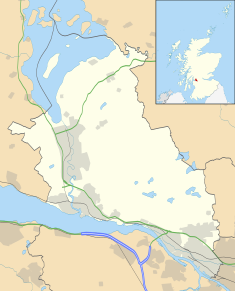Strathleven House
| Strathleven House | |
|---|---|

Strathleven House
|
|
| Coordinates | 55°58′09″N 4°34′17″W / 55.9692°N 4.5715°WCoordinates: 55°58′09″N 4°34′17″W / 55.9692°N 4.5715°W |
|
Listed Building – Category A
|
|
| Official name: Strathleven House | |
| Designated | 14 May 1971 |
| Reference no. | 115 |
|
Listed Building – Category A
|
|
| Official name: Dovecot, Strathleven | |
| Designated | 14 May 1971 |
| Reference no. | 823 |
|
Listed Building – Category B
|
|
| Official name: Coach house range and stable yard, Strathleven | |
| Designated | 14 May 1971 |
| Reference no. | 822 |
Strathleven House is an early 18th-century country house in West Dunbartonshire, Scotland. It is located in the Vale of Leven, around 3 kilometres (1.9 mi) north of Dumbarton. Built in 1700, it is probably the work of the architect James Smith, and has been described as "the earliest surviving example of the classic Palladian country house in Scotland". Strathleven House, and its 18th-century dovecote, are protected as category A listed buildings,
The Strathleven estate, then known as Kirkmichael, was owned in the 14th century by the Fleming family, passing to the Semples of Fulwood in the 17th century. In 1677 it was bought by the royalist William Cochrane, 1st Earl of Dundonald (1605–1685), who settled the estates of Strathleven and neighbouring Kilmaronock on his grandson William. This William married a daughter of James Graham, 2nd Marquess of Montrose, and sat in the Parliament of Scotland and the Parliament of Great Britain following the union of 1707.
A tower house may have existed on the estate at this time, but in 1700 William built the present house which he named Levenside. His initials and coat of arms are inscribed on the stonework of the building. The architect is unrecorded. It has been suggested that William Adam,Sir William Bruce, or Alexander McGill may have been responsible. However, on stylistic grounds James Smith is considered the most likely designer. The design of Strathleven has been compared to his houses at Newhailes near Edinburgh and Raith House in Kirkcaldy. The dovecote which stands nearby is considered to be contemporary with the house.
...
Wikipedia

